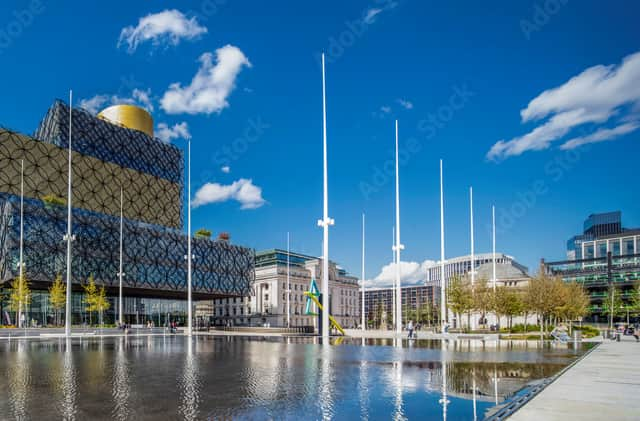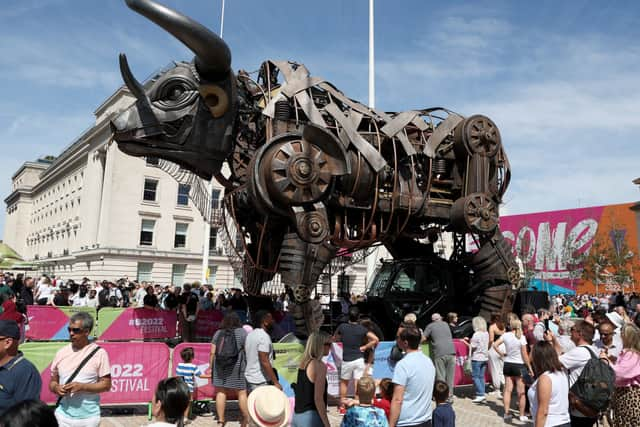Watch: The hidden history of Centenary Square in Birmingham uncovered as the former home of Cadbury & more
and live on Freeview channel 276
It’s the gleaming city centre square which attracts thousands of Brummies every day.
You’ll meet people going to work on Centenary Square in Birmingham city centre, or they may be travelling to get a tram or visit the bars, restaurants and clubs along Broad Street and Brindleyplace.
Advertisement
Hide AdAdvertisement
Hide AdIn recent weeks it has been the centre of Birmingham’s celebrations for the Royal Coronation and Eurovision Song Contest Grand Final. It is due to be the centre stage for the upcoming free ten day Birmingham Festival 2023 to celebrate the legacy of the Commonwealth Games.
Centenary Square is also home to the much loved water feature where locals can cool down as the summer gets underway and children can play.
But you may be surprised to learn that Centenary Square was once a heaving centre for manufacturing for Birmingham - and the home of the original Cadbury factory.
And just nine metres below is a railway tunnel with trains running through from the International Convention Centre (ICC) to HSBC.
Advertisement
Hide AdAdvertisement
Hide AdCentenary Square was renamed in 1989 to commemorate the Centenary of Birmingham achieving city status and was redesigned in 1991 to complement the new ICC which stands where Bingley Hall - the first purpose built exhibition hall in Great Britain - once stood.
A new TV documentary-style video has explored the proud history of Centenary Square at the end of Birmingham’s ‘golden mile’ of Broad Street.


The film focuses on the wide-open space that is flanked on one side by Baskerville House, the Library of Birmingham, the Repertory Theatre, Symphony Hall and the International Conference Centre (ICC).
Across the road and tramlines are HSBC bank’s national headquarters, then The Exchange, the former banking halls which the University of Birmingham has rejuvenated as a new meeting centre and café, and the towering Hyatt Regency Hotel.
Advertisement
Hide AdAdvertisement
Hide AdAnd on the square itself is the Hall of Memory, which for 98 years has stood as a memorial to the city’s men and women of Birmingham who gave their lives in the First and Second World Wars, and in active service since 1945.
Other features include the gilded bronze statue of Boulton, Watt and Murdoch, the three entrepreneurial engineers who pushed the mechanics behind the industrial revolution.
And then there’s the huge lake of fountains which create a wonderful summer scene and bring fun and laughter to both visiting children and adults.
Dr Carl Chinn opens a door into the area’s past in the six-minute mini documentary commissioned by Westside Business Improvement District (BID) and filmed by Local TV Birmingham. Dr Chinn explains that the square before the site was renamed in 1989 looked nothing like it does today.
Advertisement
Hide AdAdvertisement
Hide AdIn a fascinating interview with Westside BID’s general manager Mike Olley, Dr Chinn recalls that Bingley Hall stood close to various old factory buildings.


“What happened was that in the 1920s the council decided they wanted a civic centre,” Dr Chinn said. “Baskerville House is the only symbol of that civic centre, but they started to clear lots of factories, and the first sign of that was the Hall of Memory, built on land that had been industrial.”
He said that where The Exchange now stands was originally the Eagle Foundry, which later became the Municipal Bank. “And behind that was the original main Cadbury’s factory in Bridge Street,” the historian added.
Dr Chinn said: “Broad Street was probably the most important single manufacturing street in Birmingham because here we had a great factory that tied into the screw trade, Nettlefolds and Chamberlain.”
Advertisement
Hide AdAdvertisement
Hide AdDr Chinn added that the area declined in the 1970s and early 1980s when the canals were “a mess”, before the building of the ICC and the Repertory Theatre, and Broad Street’s development as a “golden mile” for restaurants, bars and clubs.
Also interviewed in the documentary is Jim Wilson, described by Mr Olley as “the man that built the new Centenary Square”.
Mr Wilson, recently retired as the city council’s project delivery manager, explains how the square was “built to last” with heavy granite lying on top of a pre-cast concrete sub-base. It had to be solid, he says, as just nine metres below runs a railway tunnel.
He also recalls how he persuaded the council to run an international design competition to create Centenary Square, attracting 185 entries from 32 countries. This resulted in the intricate landscaping of pathways, fountains and flowerbeds in between 43 giant lighting columns.
Advertisement
Hide AdAdvertisement
Hide AdAt the end of the documentary, Mr Olley concludes: “So there you have it: Centenary Square, a world class plaza in the heart of Westside, Birmingham, somewhere for us Brummies to congregate and celebrate for hopefully many years to come.”
Comment Guidelines
National World encourages reader discussion on our stories. User feedback, insights and back-and-forth exchanges add a rich layer of context to reporting. Please review our Community Guidelines before commenting.
